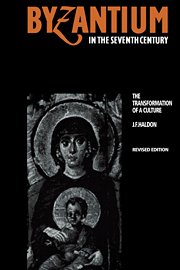Book contents
- Frontmatter
- Contents
- List of plates
- List of maps
- Preface and acknowledgements
- Preface to the revised edition
- List of abbreviations
- The sources
- Introduction
- 1 The background: state and society before Heraclius
- 2 The East Roman world c. 610–717: the politics of survival
- 3 Social relations and the economy: the cities and the land
- 4 Social relations and the economy: rural society
- 5 The state and its apparatus: fiscal administration
- 6 The state and its apparatus: military administration
- 7 Society, state and law
- 8 The imperial church and the politics of authority
- 9 Religion and belief
- 10 Forms of social and cultural organisation: infrastructures and hierarchies
- 11 Forms of representation: language, literature and the icon
- Conclusion: The transformation of a culture
- Addendum: Further observations on the question of the late ancient city
- Bibliography
- Index
9 - Religion and belief
Published online by Cambridge University Press: 13 November 2009
- Frontmatter
- Contents
- List of plates
- List of maps
- Preface and acknowledgements
- Preface to the revised edition
- List of abbreviations
- The sources
- Introduction
- 1 The background: state and society before Heraclius
- 2 The East Roman world c. 610–717: the politics of survival
- 3 Social relations and the economy: the cities and the land
- 4 Social relations and the economy: rural society
- 5 The state and its apparatus: fiscal administration
- 6 The state and its apparatus: military administration
- 7 Society, state and law
- 8 The imperial church and the politics of authority
- 9 Religion and belief
- 10 Forms of social and cultural organisation: infrastructures and hierarchies
- 11 Forms of representation: language, literature and the icon
- Conclusion: The transformation of a culture
- Addendum: Further observations on the question of the late ancient city
- Bibliography
- Index
Summary
THE CHURCH AND CHRISTIANITY: NEO-CHALCEDONIAN UNIVERSALISM AND HETERODOX PLURALISM
Religion and belief are not, of course, synonymous. In this chapter, I want to look at the ‘public’ and the ‘official’ aspects of seventh-century religious and ideological history, rather than at the individual psychology of belief in the early medieval world of the Eastern Roman empire. But since the latter subject is, in several ways, the prerequisite for an understanding of the world as it was perceived and understood by people of this period, a few words on the assumptions which inform my approach are in order.
Although several scholars have approached this problem, of the Byzantine mentalité, at a general level, their work has on the whole been descriptive rather than analytic. That is to say, Byzantinists have generally tended towards a presentation of the data from the sources on the forms of belief and its appearance – the specific ideas which together form the imperial ideology, or orthodoxy, or attitudes to the everyday. In the process, the question of the actual generation and reproduction of ideas in their social-psychological context tends to be forgotten. More particularly, the question of the relationship between what people think (as this is presented at different levels in our sources, through histories, hagiographies, letters and so on), about both themselves and about their perceptions of the world and how they act upon that world, how those perceptions inform the possibilities open to them in respect of their social existence has been neglected.
- Type
- Chapter
- Information
- Byzantium in the Seventh CenturyThe Transformation of a Culture, pp. 324 - 375Publisher: Cambridge University PressPrint publication year: 1990

